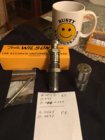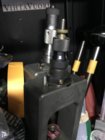Lee collet dies are fantastic. It cut the runout from my bushing neck sizing dies in halfI take it you guys are referring to using the Lee collet dies? Since I do not currently own a custom set of dies, I always try and use a body die followed by an expand mandrel to set the desired neck tension: I cringe at the thought of pulling the expander ball back through the case neck.
However, I would be open to giving the collet die a try.
Thanks
Install the app
How to install the app on iOS
Follow along with the video below to see how to install our site as a web app on your home screen.
Note: This feature may not be available in some browsers.
You are using an out of date browser. It may not display this or other websites correctly.
You should upgrade or use an alternative browser.
You should upgrade or use an alternative browser.
Considering Going With a Custom Die
- Thread starter sawacs
- Start date
Lee collet dies are fantastic. It cut the runout from my bushing neck sizing dies in half
I just remembered I have a few sets of the LEE dies I purchased years ago for use with the 223, 308, and 30-06. However, before ever really giving the dies a chance, I moved on to other dies: I do use the factory crimp die. Maybe I should go back and give them a try because I believe each die came with a collet die..doh!
Cheers!
I know they are not a high end die, but for 30. Dollars, they produce a pretty straight plinking or hunting round, I get 1/4 inch groups using itI just remembered I have a few sets of the LEE dies I purchased years ago for use with the 223, 308, and 30-06. However, before ever really giving the dies a chance, I moved on to other dies: I do use the factory crimp die. Maybe I should go back and give them a try because I believe each die came with a collet die..doh!
Cheers!
Is this die hardened? Does a file cut it?No need for a custom Die for my 308.
Wilson doesView attachment 1071361 the trick, even comes with both size decapper rods.
Smoothest Die I own and minimum sizing as well.
Heat treated and case hardened beyond grade 8 is their claimIs this die hardened? Does a file cut it?
Dusty Stevens
Shiner
+1 ...simple fix for runout issues...Lee collet dies are fantastic. It cut the runout from my bushing neck sizing dies in half
Similar threads
- Replies
- 11
- Views
- 1,016
- Replies
- 20
- Views
- 1,009
Upgrades & Donations
This Forum's expenses are primarily paid by member contributions. You can upgrade your Forum membership in seconds. Gold and Silver members get unlimited FREE classifieds for one year. Gold members can upload custom avatars.

Click Upgrade Membership Button ABOVE to get Gold or Silver Status.
You can also donate any amount, large or small, with the button below. Include your Forum Name in the PayPal Notes field.
To DONATE by CHECK, or make a recurring donation, CLICK HERE to learn how.

Click Upgrade Membership Button ABOVE to get Gold or Silver Status.
You can also donate any amount, large or small, with the button below. Include your Forum Name in the PayPal Notes field.
To DONATE by CHECK, or make a recurring donation, CLICK HERE to learn how.











